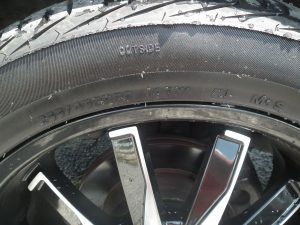Understanding Tire Numbers and Letters
Posted Monday, Nov 19, 2018
Have you ever wondered what all of the letters and numbers on the side of your vehicle’s tires mean? If you’re like most of us, you simply drive to a tire store and choose from the tire options the salesman shows you on his computer monitor without considering tire numbers and letters. However, having a working knowledge of the letters and numbers on the tires could positively influence which tire you purchase. So, let’s look at what those letters and numbers mean.
If you look at the photo from reasonablerides.com below, you’ll notice that the tire is coded thus: 255/45ZR20 105W XL M+S.
 Most often, any tire you view will start with a “P.” This simply tells you that it is a passenger vehicle tire, at least one standardized to American designation. If the tire has no letter as the first digit, it is made to European specification. If the initial digits are “LT,” it signifies that the tire is for light trucks. First, you’ll notice the tire below is void of a letter at the very beginning, so it as a Euro-spec tire. You may just as easily encounter a P255…
Most often, any tire you view will start with a “P.” This simply tells you that it is a passenger vehicle tire, at least one standardized to American designation. If the tire has no letter as the first digit, it is made to European specification. If the initial digits are “LT,” it signifies that the tire is for light trucks. First, you’ll notice the tire below is void of a letter at the very beginning, so it as a Euro-spec tire. You may just as easily encounter a P255…
The 1st three digit number (255) is the width of the tire in millimeters. So, this particular tire is 255mm wide. What does this mean to you? There’s only a certain range of widths that will fit your particular wheel, but within that range the narrowest tire will have the best fuel economy while the widest tire will have the most traction for braking and cornering.
This three digit number is followed by a slash and a two digit number (/45), which reveals the aspect ratio. In other words the two digit number shows the height’s percentage of the width. In our example, the height of the tire is 45% of the width. Since the width is 255mm’s, the height is about 115mm’s. When you’re deciding on your aspect ratio, keep in mind that the smaller ratio will be the most responsive tire while the larger ratio will give the most comfort.
Next, you’ll usually see an R, which simply means radial (ZR). Obviously, our example also has a Z, which means the tire is rated to exceed 149mph; some manufacturers started placing the speed rating here years ago, but you probably won’t see a letter here unless it’s a Z rated tire. We’ll discuss speed ratings in more depth in a moment.
The next two digit number shows the size wheel the tire is made to fit, in our case (20), 20 inches. This won’t really affect your tire choice because you have to purchase the one that fits your wheel.
The next three digit number (105) is the load rating, or the maximum amount of weight that tire can support. Since cars have four wheels, each supports ¼ of the vehicle’s gross weight. These ratings can range from 70 (739 lbs) to 126 (3748 lbs). In our case 105 means the tire can support 2039 lbs. Unless you intend to haul extra weight, you probably are fine in choosing a tire with the same load rating as what you currently have installed.
The next letter (W) specifies the speed rating, or the maximum speed at which the tire is rated to function without failing. On most cars, these range from L (75 mph) to V (149 mph), but you’ll probably be considering R (106), S (112), T (118), U (124), or H (130). If you own a particularly sporty car, you may be considering V (149), W (168), or Y (186). I don’t advocate speeding, so I’ll leave speed rating to you.
The next two letters may or may not appear on the tire you’re considering. In our case, the XL states that the tire is rated for a higher load.
Finally, if there is a M+S on your tire, as it is ours, it signifies that the tire is rated for all seasons (mud and snow). Some car enthusiasts have a separate set of tires for winter driving. If that’s not for you, purchase tires with M+S rating.
If you look closely at your tires, you’ll possibly see some smaller tire numbers and letters. We’ll look at those in another post. As for now, you’re better prepared to select your next set of tires.
Photo courtesy of reasonablerides.com